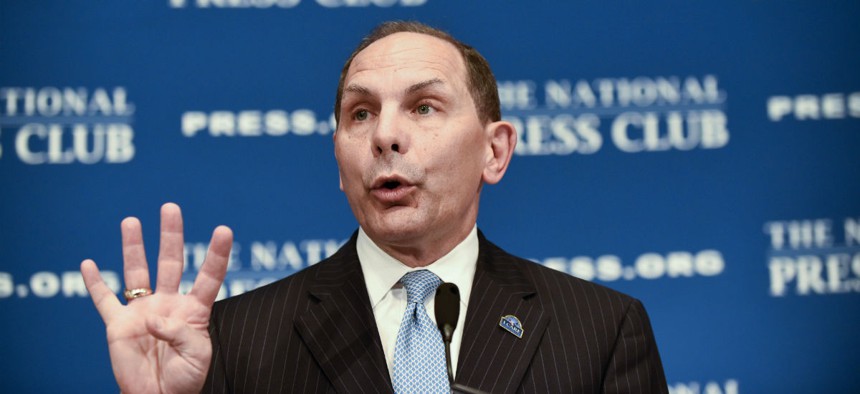
VA Secretary Bob McDonald spoke about the state of the Veteran Affairs Department at a luncheon at the National Press Club in Washington in November. Sait Serkan Gurbuz/Associated Press
VA Secretary Says Job Performance Standards Have Been ‘Too Low’
Too many "outstanding" evaluations don’t make sense for an agency that gets low ratings from employees, Bob McDonald says.
The Veterans Affairs Department has to raise the bar on job performance expectations for employees to change an entrenched, bureaucratic culture that has given rise to mismanagement at the government’s second-largest agency, says VA Secretary Bob McDonald.
“Our standards have been too low,” McDonald told lawmakers during a recent Senate Veterans’ Affairs Committee hearing in which he outlined the department’s accomplishments and his 2016 priorities for improving service to vets and restructuring the way the VA does business.
“Many of our leaders, when I first looked at their performance evaluations, everybody rated everybody 5 – outstanding,” McDonald said, in response to a question from Sen. Mike Rounds, R-S.D., on how to effect culture change and hold people accountable. “How can you be rated outstanding when your employees rate your organization as one of the worst in government? That doesn’t make sense.”
VA did rate fewer of its senior executives as outstanding in fiscal 2014 than it did in fiscal 2013 (McDonald arrived at the VA in July 2014): 19.1 percent of SESers compared to 21.4 percent, according to an October 2015 Office of Personnel Management report. That percentage of senior executives rating outstanding was the lowest of the agencies that submitted information on SES performance ratings and bonuses in fiscal 2014. But the VA also rated 69 fewer senior executives in fiscal 2014 than it did in fiscal 2013: 272 compared to 341. VA ranked toward the bottom of the nonprofit Partnership for Public Service’s 2015 Best Places to Work in the Federal Government analysis.
In the 2015 OPM report, agencies submitted rating and pay data for more than 7,500 SES members (including career, non-career and term-limited SES); of that group, agencies rated 90.7 percent of SES members, with 48.5 percent rated at the highest level (outstanding or equivalent).
OPM is urging federal agencies to make more meaningful distinctions in performance ratings and bonuses for senior executives in 2016.
“More is required to meet the highest performance level (i.e., outstanding) in comparison to the standards set for the next level (e.g., exceeds fully successful level), and so on for each rating level,” said a Jan. 12 memo from OPM Acting Director Beth Cobert. “These distinctions among standards for various performance levels during the establishment of the performance plan ensures that the SES member and his or her rating official are aware of the standards upon which performance ratings will be based.”
A 2015 report from the Government Accountability Office found that about 85 percent of career senior executives received “outstanding” or “exceeds fully successful” ratings in their performance reviews between fiscal years 2010 and 2013, at the same time that agencies made smaller distinctions in the amount of individual bonuses. That has created a system where nearly everyone is considered outstanding, and truly exceptional senior executives are treated similarly to their above-average peers when it comes to performance ratings and awards, GAO concluded. Agency officials at that time offered several reasons for this trend, including the belief that the highest performance ratings were justified for many senior executives (after all, this is the top cadre of career officials) to the perception that a “fully successful” rating is considered mediocre among employees, despite that not actually being true.
McDonald, who has been under pressure from Congress and others to more quickly fire bad apples, has said repeatedly that training VA employees and leaders is a key component to changing the department’s culture and instilling greater accountability. During the Jan. 21 Senate hearing, he cited the VA’s “leaders developing leaders” initiative, and said that all employees in 2016 will have a customer service standard included in their performance plans.
The former chief executive officer of Proctor and Gamble acknowledged the need to fire people when warranted, and once again, touted the fact that since August 2014, 2,600 employees have been removed from their jobs. That’s about the number of VA employees the department typically fires in a year – a fraction of its 300,000-plus workforce.
“I know the importance of getting people who violate our values out of the organization,” McDonald said. “We’re doing that, we’re doing it consistent with what they’ve done, and we’re doing it consistent with due process. We know that’s necessary for cultural change.”
The 2014 Veterans Access, Choice and Accountability Act makes it easier to demote and fire VA senior executives. The House passed a bill in July that would make it easier to fire all VA employees; similar legislation still is pending in the Senate. Many lawmakers of both parties and other observers are frustrated with the department’s inability to quickly shed poor performers or those engaged in misconduct, despite the 2014 Choice Act. Critics of the expedited firing authority—and attempts to extend it beyond VA’s senior executives—have said it violates career employees’ due process rights.
“We have enough authority to fire people,” McDonald said in response to a question from Sen. Joe Manchin, D-W.Va., who specifically asked about McDonald’s ability to “move around” the department’s “top people.” The VA chief noted, as he did in his opening statement, that “10 of my 16 top leaders are new since I was secretary.”
But at least some of those leaders are not career senior executives protected by due process. In other words, they can be fired very easily.







